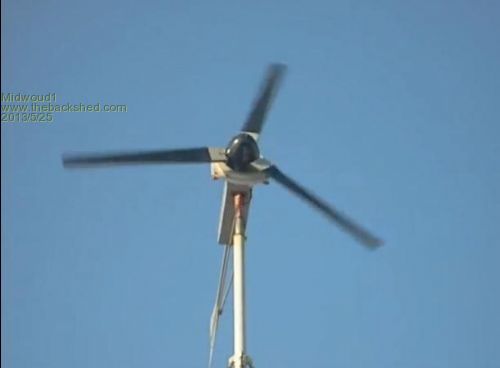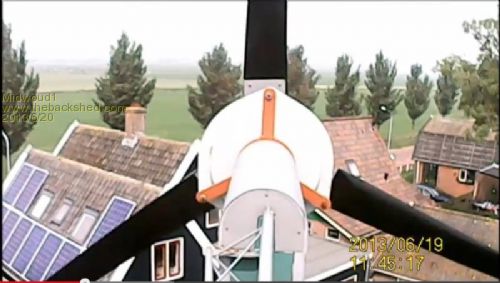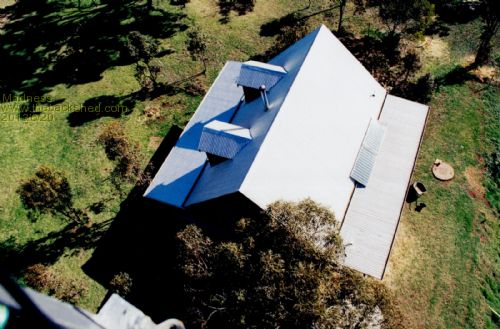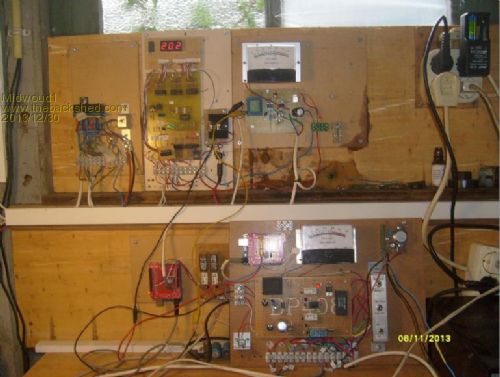
|

|
Forum Index : Windmills : Variable Pitch Design
| Page 1 of 2 |
|||||
| Author | Message | ||||
| maskedmonkey2 Newbie Joined: 24/05/2013 Location: United StatesPosts: 1 |
Hi all, I stumbled across the forum while looking at various windmill things (when I should have been working) and hope I can tap into some knowledge from experience here. I am an industrial engineering intern at a local cast iron foundry in Texas, therefore I have a complete machine shop with CNC lathes and mills at my disposal. Not to mention the ability to cast my own parts (from the excess metal in the ladle instead of pouring half a part they "pig" it, if I make my own mold they will pour the pig into my mold and magically a part will appear.) My brother is an aircraft mechanic and we have decided that we would like to build a turbine in order to tap into the constantly blowing west Texas winds. We have decided that if we are going to make a go of it, it better be cool, so we decided to do an active pitch control using a microcontroller to keep the prop spinning at optimal speed and as well as to serve as protection for overspeed. I scrounged up a 1/2hp 90VDC 1750RPM motor that seemed just about ideal for the application, we are planning on charging a 12v battery bank and possibly a grid tie inverter to put it to good use. I have looked at many variable pitch designs and for the most part see that they are using gears and a stepper motor. I was curious why no one has implemented a swash plate design like what is used for helicopter rotors (specifically tail rotors) I've thrown together a preliminary design in solidworks. It still needs the other two blades put on, another pillow block for preload, and the driving mechanism for the slip yoke (which I have partway modeled using an old 12v drill). I also am not sure just how long the blades should be though I'm sure there are some calculations that need to be made. 

Any thoughts at this point in the process will be much appreciated and I look forward to hearing from you all. |
||||
| MOBI Guru Joined: 02/12/2012 Location: AustraliaPosts: 819 |
It looks impressive and I'm sure since you have access to all the right gear you can make it work. I for one wouold like to see it trialled as I have often thought of the idea - just don't have the right gear. I guess the other reason it isn't often done is the KISS principle. A lot of engineering for little return. I think a furling system would be more beneficial imo. Maybe we are missing something "down under", but why is it that only Texans seem to advertise their origins? Is there something special? I'm not having a go at anyone, just a curious observation. David M. |
||||
fillm Guru Joined: 10/02/2007 Location: AustraliaPosts: 730 |
I think you might need to rethink the generator ( 230rpm @ 12V ), might not lend itself to such an ambitious project . My thoughts are also what MOBI has also said, that for small HAWTs under 3m furling is all that is needed ,3~ 3.4 is grey, its really only when you start getting up into the bigger blade sets and big power Variable Pitch is warranted, and I don't know why any one would want to build a 4 bladed windmill ... Might be the TEXAS thing . 
Also, 12v is really not the ideal system for high output , 1Kw = 80+ Amps ( BIG WIRES ) But you sound like you have some good engineering assets at your disposal and if you want to do it ... Go For It PhillM ...Oz Wind Engineering..Wind Turbine Kits 500W - 5000W ~ F&P Dual Kits ~ GOE222Blades- Voltage Control Parts ------- Tower kits |
||||
MacGyver Guru Joined: 12/05/2009 Location: United StatesPosts: 1329 |
maskedmonkey2 First off, welcome to the 4m. I'm a fellow Texan, a transplant from the beach @ San Diego, CA. None the less, in answer to Mobi's question about why Texans are so forthwith about their state, it's because Texas is the land of 'anything goes'. It's all good here and I for one am proud to be a Texan; I'll never stray anywhere else. This place is God's country (tornadoes notwithstanding!). Anyway, I would re-think a lot of things here. First off, a controlable-pitch propeller (turbine) is a great idea, but it doesn't really matter until your blade diameter gets larger than about 12 feet. The smaller versions, as you made mention of, like a tail rotor on an ghetto bird, are operable, but on a small "driven" turbine blade, they make little to no change in things and thus, though really cool to design, build and watch, are pretty useless. As for " . . . I'm not sure how long the blades should be." here's a Link, which will get you to a place where you can actually calculate that. Just leave most of the numbers alone for now and fill in your proposed or desired blade length. The calculator will do all the fancy math and come up with power-production results at various wind speeds. I live on the prairie and have about 12 to 20 knott winds continuously every single day of my life, so I'm in high cotton as far as wind. I will be slapping together a 3KVA VAWT (that stands for Vertical-Axis Wind Turbine) in the very near future. I will post the build here on the 4m. You may want to wait for that before spending gobs of money and time on your project. My entire "windmill" will cost me less than a hundred bucks (not counting the 3KVA alternator, which I will buy commercially and use against a transmission). . . . . . Mac Nothing difficult is ever easy! Perhaps better stated in the words of Morgan Freeman, "Where there is no struggle, there is no progress!" Copeville, Texas |
||||
| jorn Newbie Joined: 30/12/2012 Location: NetherlandsPosts: 22 |
Pitch control: Why not just look at the Dutch Ecologie Forum http://www.ecologieforum.eu/viewtopic.php?f=23&t=2566&start= 180 Greetings Jorn |
||||
| Midwoud1 Newbie Joined: 25/12/2012 Location: NetherlandsPosts: 23 |

http://www.fieldlines.com/index.php/topic,145925.0.html?PHPS ESSID=ed13e6d46600cbe9330f239de089f161 I have an active-pitchcontrolled windgenerator 3 mtr.prop succesfully 2 years . With an actuator and micro-controller Arduino - Frans - (midwoud1) |
||||
| Midwoud1 Newbie Joined: 25/12/2012 Location: NetherlandsPosts: 23 |
http://www.fieldlines.com/index.php?topic=145925.0 Fieldlines-forum >> Wind >> page 2 >> Active-pitchcontrol ( midwoud1 ) 14 pages |
||||
| Midwoud1 Newbie Joined: 25/12/2012 Location: NetherlandsPosts: 23 |
http://www.youtube.com/watch?v=FzRJQuWEcPg |
||||
| jorn Newbie Joined: 30/12/2012 Location: NetherlandsPosts: 22 |
Hey Midwoud, Nice work. Why you have black-colored blades? Greetings Jorn |
||||
| Midwoud1 Newbie Joined: 25/12/2012 Location: NetherlandsPosts: 23 |
Jorn. I painted it with matt black lacquer, to avoid sun-blink reflection. And quick snow drop off. Rgds. - Frans - |
||||
| Midwoud1 Newbie Joined: 25/12/2012 Location: NetherlandsPosts: 23 |
Windturbine cam variable blades http://www.youtube.com/watch?v=69HZD4rG__U 
|
||||
| domwild Guru Joined: 16/12/2005 Location: AustraliaPosts: 873 |
The Jacob's solution to variable-pitch props is very elegant. No electronics and no centrifugal counterweights. The prop wants to fly away due to centrifugal force and is spring-loaded and a curve is milled into the tubular prop connection, which then ensures the prop turns into coarser pitch at higher RPM. I am sure Dr Google has an engineering diagram. Taxation as a means of achieving prosperity is like a man standing inside a bucket trying to lift himself up. Winston Churchill |
||||
Madness Guru Joined: 08/10/2011 Location: AustraliaPosts: 2498 |
Dunlites also used weights, each blade shaft had a roller on a shaft mounted at a right angle. These fitted into what is like a pulley with parallel inside edges. This pulley had a large spring pushing it back towards the tail and the tension could be adjust to control feathering. This system worked however it had it's disadvantages. In storm conditions the generator would spin very fast even though it was feathered a lot. It was quite difficult to stop it in these conditions, seems that the feathered blades developed a lot of torque in the high winds. Applying the brake would not stop until there was a drop in wind speed. Having full control over the feather is a good thing IMHO. Also it could be used as a battery voltage regulator. One way to add some safety in case of failure is to have the feathering spring loaded so that if there is no power supplied it will return to fully feathered position. Midwoud1 do you have to climb up to the generator to retrive a SD card or is there a data cable connected to the generator? 
Would have been nice to have a rotatable camera on my generator 24 Metres off the ground. There are only 10 types of people in the world: those who understand binary, and those who don't. |
||||
| Midwoud1 Newbie Joined: 25/12/2012 Location: NetherlandsPosts: 23 |
Domwild , Madness thanks. Yeah Jacobs ,Bergey ,and Dunlite are great designers. I have had passive control with weights and still running fast in storm like Madness mentioned. For me it was a challenge to make active pitch control. Test experimental. I know a bit about mechanical engeneering and electronics. The turbine is 2-1/2 years running with no problems. It has a tilt tower 10 meters high. With rope and 2+3 sheaves. Up 15 minutes and down 15 minutes. Rgds. -Frans- |
||||
| Don B Senior Member Joined: 27/09/2008 Location: AustraliaPosts: 190 |
Hi maskedmonkey, and welcome to the forum Before you get too far down the track with your variable pitch rotor design, there are a few fundamentals of physics pertaining to wind turbines that you need to note: For any given wind speed, the power that you can harvest from the wind is proportional to the square of the rotor diameter. Put another way, if you double the rotor diameter, you can get four times the power from the same wind speed. The power in the wind increases to the cube of the wind speed. This means that, if the wind speed doubles, you have to deal with eight times the power. It is this relationship that can quickly overspeed your turbine and turn it into junk in high winds. Most variable pitch (or other furling) arrangements are more focused on spilling excess wind to avoid destructive overspeed than extracting greater efficiency, except for the very large commercial ones. Even they have their operating wind speed limits. With turbine blades, there is a constant relationship between the speed of the tips of the blades and the wind speed for maximum efficiency. This says that if the wind speed doubles, the blade (and hence shaft) speed also needs to double. This is called the tip speed ratio. Note particularly that the larger the turbine diameter, the lower is the shaft speed to obtain a given tip speed and maintain the optimum tip speed ratio. Just look at the slow speed of the really big commercial ones. The optimum tip speed ratio exists in a band which depends upon the number of blades. The more blades, the lower the optimum tip speed ratio, and hence shaft speed. For three blades, the blade tips need to run at 4 to 6 times the wind speed. Three blades are perhaps the best compromise to give reasonable shaft speed and stable operation. The tip speed ratio for four blades is lower, and hence less suitable for the operating speed of the motor that you are planning to use as a generator. When it comes to the number of blades, more doesn't mean better. For maximum efficiency, properly designed blades will have a selected tip speed ratio that sets the angle to the incoming air flow along their length. This will mean that the blades need to be twisted and tapered for maximum efficiency (meaning getting the most energy possible for a given wind speed and rotor diameter). Note also that efficient wind turbine blades and propellors are quite different, and a propellor will not operate efficiently if pressed into service as as a wind turbine. When a properly designed wind turbine blade is not turning, its tip is deeply stalled relative to the incoming wind. It will therefore need higher wind speed to start it turning than the wind speed at which it can run and produce useful power once turning. One way of getting the turbine to start at a lower wind speed is to change the pitch when stopped. There is at least one wind generator on the market that changes pitch to start, and also changes pitch to control overspeed. If you are contemplating a four blade turbine of any reasonable size, then its efficient operating speed at average wind speed will be probably only 20% of the designed shaft speed of the motor that you plan to use as a generator. The output voltage will therefore only be 20% of 12 V also. This is why most small wind turbines use a specially designed low speed generator - often an axial flux type. These will tend to have a larger diameter to let their magnets turn at a useful speed with a low shaft speed. You could consider gearing your turbine up to turn the motor shaft at a faster speed but, unfortunately, the gearing losses will subtract from operating efficiency. Please don't let any of these remarks discourage you from proceeding with your project, I am very envious of the facilities that you have access to. But it is always better to have an understanding of the principles that you are dealing with so that your efforts can be directed to obtaining the best results. Regards Don B |
||||
| jorn Newbie Joined: 30/12/2012 Location: NetherlandsPosts: 22 |
Maskedmonkey2, We really are a bit curious about your developments with regard to active pitch control design. Greatings Jorn |
||||
| Warpspeed Guru Joined: 09/08/2007 Location: AustraliaPosts: 4406 |
There is only really an optimal blade speed if the wind machine is directly coupled to an ac alternator that is then directly hard wired into the grid. It HAS to output 50/60 Hz over all usable wind speeds, which requires a totally fixed constant operating rpm. The machine can only run at ONE very specific design rpm, and you then vary the pitch to get best blade lift drag ratio at the prevailing wind speed. Basically you tweak the pitch for max rotor torque, and feed max current into the grid with an MPPT circuit. Output voltage and fequency being absolutely fixed by the grid. With smaller machines such as ours (generating rectified dc current) actual working rotor speed is of no real importance. The faster the wind blows, the higher the tip speed, and the greater the electrical output. Why would you wish to slow it down and reduce the output with less pitch, or increase pitch up to the point of blade stall ? A much simpler and much easier way to do it is to allow the rotor to seek its own rpm and adjust the electrical loading on the machine with an MPPT system to match the machine's output voltage to the system operating voltage. If the machine is loaded up near stall, the MPPT system will reduce the loading and allow rpm to increase to the most efficient point. If the rotor is overspeeding with insufficient electrical load, the MPPT will increase the loading to the most efficient point. This effectively alters the relationship between air speed and tip speed, which is exactly what variable pitch does, but is vastly simpler. Unless you have a genuine reason to keep blade speed absolutely constant, variable pitch is a complete waste of time. Cheers, Tony. |
||||
Madness Guru Joined: 08/10/2011 Location: AustraliaPosts: 2498 |
There is no need for constant speed for a DC system however variable pitch is used in the old Dunlite's to stop over speed. It could also be used to regulate the output when your batteries are full. There are only 10 types of people in the world: those who understand binary, and those who don't. |
||||
| Midwoud1 Newbie Joined: 25/12/2012 Location: NetherlandsPosts: 23 |
Test setup electronica circuit, active pitchcontrolled blades . Controlled by Arduino . Constant speed system. Rgds: Frans. http://www.youtube.com/watch?v=xGMj90mXcwI 
|
||||
| anteror Senior Member Joined: 06/10/2009 Location: FinlandPosts: 189 |
This really will begin.. a new beginning to all this ! We have engineers and experts here now !! 
Perhaps and I really hope all the engineers and experts will join together and direct their interest to this. This is the best and most interesting writing in this forum, for small wind power ! 
Antero Rantanen Finland antero.choiceforwind.. / sci.fi +358405115245 Fax; +35828415818 |
||||
| Page 1 of 2 |
|||||